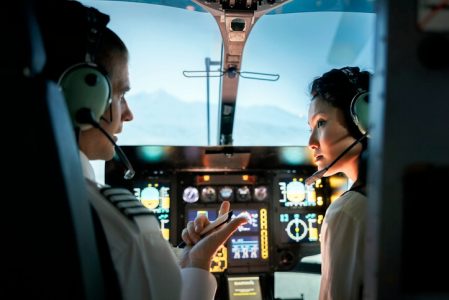Smooth Takeoff: Why Every Flight Needs a Strong CRM Strategy
Professional piloting has revolutionized because of the increased level of communication and collaboration among crew members. As a result, aviation safety is significantly improved – accidents and incidents have decreased dramatically compared to past years. Despite these successes however, there are still occasional mishaps that could be avoided with better crew resource management (CRM) between pilots in the cockpit.
An intense incident between two pilots aboard a Pilatus PC-12 in October 2021 has been subject to an accident investigation revealing that this dangerous event was likely caused by ineffective communication.
The aircraft encountered turbulence during the descent and, though the radar showed weak precipitation ahead, the copilot could see another cloud mass and asked several times for the captain to make a turn away from it. The captain ignored these requests, resulting in dangerously low altitude. Finally, desperation led the captain to take evasive action without adjusting power or warning of his intentions—triggering stall warnings as they descended 600 feet below MSA.
It’s not clear if the captain made the sudden turn out of anger or if he realized the FO was right, but either way, the communication between the two was not at all effective. The FO was not being heard and the captain was not responding to her requests. Without effective collaboration between cockpit partners, safety is compromised: no one’s voice should go unheard.
Benefits of CRM
What is CRM? Crew Resource Management (CRM) is an approach used in aviation to manage human factors that can lead to errors and prevent accidents. It emphasizes teamwork, effective communication, and situational awareness. Here is a list of reasons why CRM is crucial to flights:
- Improved communication: Effective communication is vital in a high-pressure environment such as aviation. By utilizing CRM principles, crew members can communicate more effectively, reducing the risk of misunderstandings or miscommunications that can lead to errors.
- Enhanced situational awareness: Situational awareness is crucial for safe flight operations. Through CRM training, crew members can develop a shared understanding of the current situation, including potential risks and hazards, allowing them to make informed decisions.
- More effective decision-making: In complex situations, crew members must make decisions quickly and effectively. CRM training can help crew members develop critical thinking skills, enabling them to make better decisions under pressure.
- Improved teamwork: Aviation is a team effort, and effective teamwork is essential for safe operations. By using CRM principles, crew members can work together more effectively, ensuring that all tasks are completed efficiently and safely.
- Reduced error rates: By working together and utilizing CRM principles, crew members can reduce the risk of errors that can lead to accidents. This includes errors related to communication, decision-making, and task execution.
Overall, crew resource management is key in providing a safe flight with maximum efficiency. All pilots need to have an understanding of the principles and communication techniques embedded within CRM so they can make informed decisions together as a team. Furthermore, CRM is strategically important for any kind of aircraft from small general aviation to commercial airliners; its techniques ensure that the occasional errors that may occur during flight operations don’t turn into safety concerns or disciplinary issues. Pilots must be engaged not only during flight, but during briefings and de-briefings with the flight attendant staff and other flight personnel. This ability to work effectively with each other has been proven to go far beyond enhancing passenger experience; it provides security by allowing everyone to figure out how to manage potential problems in a timely manner before they become dangerous occurrences. Pilots must understand the importance of crew resource management and invest the time required in order to excel professionally.
RELATED CTS TRAINING










